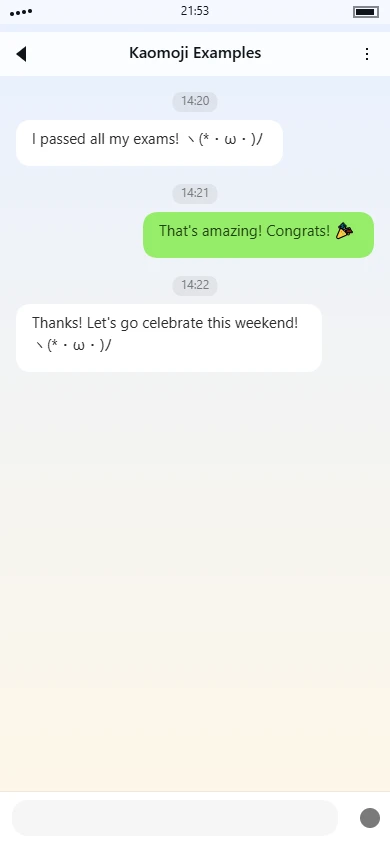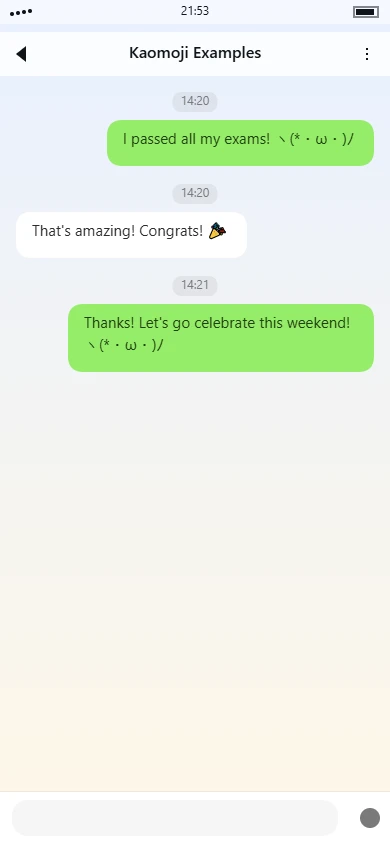ヽ(o^▽^o)ノ kaomoji Meaning | Usage Tips

Overview
This kaomoji presents a stylized representation of a person waving both hands in a cheerful manner. The overall structure consists of two hands positioned at the sides, with a central face element that conveys happiness through its facial expression. The symmetrical arrangement creates a balanced visual composition that suggests movement and energy.
The character composition utilizes Japanese katakana and special symbols to construct the figure. The hands are represented by ヽ and ノ, which are katakana characters that visually resemble raised arms. The central face is enclosed within parentheses, creating a rounded facial contour. The eyes are depicted using lowercase 'o' characters, while the mouth area features a combination of caret symbols (^) and a triangle shape (▽) that forms a smiling expression.
Symbol Breakdown
- ヽ and ノ: These katakana characters serve as the left and right hands respectively, angled in a way that suggests waving motion
- ( ): The parentheses create the facial boundary, giving the impression of a rounded head or face shape
- o o: The lowercase 'o' characters function as eyes, positioned symmetrically on either side of the face
- ^▽^: This combination creates the mouth area, with the caret symbols suggesting upward-curving cheeks and the triangle forming the main smiling mouth
- Full-width characters: The use of full-width symbols (^ instead of ^) provides better visual spacing and balance
Emotion & Aesthetic Analysis
This kaomoji primarily conveys happiness and friendliness through its smiling facial expression and waving hand gestures. The upward-curving mouth elements combined with the symmetrical eye placement create an expression of genuine pleasure. The waving hands add an element of greeting or celebration, suggesting the character is either welcoming someone or expressing joy about something.
The visual style leans toward the cute or charming aesthetic common in Japanese internet culture, with rounded forms and simplified facial features. Compared to simpler happy kaomoji like (^_^), this version includes additional elements of physical movement through the hand gestures, making it more dynamic and expressive. The overall effect is slightly more energetic than static smiling faces but maintains a similar level of approachability and positivity.
In practical usage, this kaomoji often appears in contexts where someone wants to express cheerful greeting, happy acknowledgment, or positive excitement. It works well in casual online conversations, social media posts, and messaging platforms where visual expression enhances textual communication. The combination of facial expression and body language makes it versatile for various positive interactions while maintaining a lighthearted tone.
Tag categories
Use tags to quickly understand this kaomoji.
Expression tags
Click tags to explore related kaomoji.
Usage guide
Usage Guide for ヽ(o^▽^o)ノ
This cheerful kaomoji represents a person waving both arms in the air with a bright, happy expression. The character combination creates the impression of someone joyfully celebrating or expressing pure delight, making it perfect for conveying positive emotions in casual digital communication. The symmetrical arms (ヽ and ノ) frame the happy face (o^▽^o), creating a balanced, energetic visual that suggests unrestrained happiness. You'll typically see this kaomoji used among friends, in gaming communities, and on social media platforms where users want to express genuine excitement without resorting to formal language.
The kaomoji carries a tone of innocent enthusiasm rather than sarcasm or irony. It's particularly effective for sharing personal achievements, celebrating small victories, or reacting to good news from friends. The expression works well across various platforms including Discord, Twitter, casual messaging apps, and gaming chats where users appreciate visual expressions of emotion. Its childlike quality makes it suitable for lighthearted contexts rather than serious discussions, and it pairs well with exclamation points and other celebratory elements.
Common Use Cases
- Celebrating personal achievements like completing a difficult task or reaching a milestone
- Reacting to exciting news from friends in group chats or private messages
- Expressing joy after winning a game or achieving a high score in gaming communities
- Sharing happiness about upcoming events like vacations, concerts, or special occasions
- Responding to cute animal photos or heartwarming content on social media
- Showing excitement about food, especially when sharing pictures of delicious meals
- Expressing gratitude when someone does something unexpectedly kind or helpful
- Reacting to funny memes or entertaining content that genuinely makes you laugh
- Celebrating seasonal events like holidays, birthdays, or special calendar dates
- Showing support and enthusiasm for friends' accomplishments and good news
- Expressing childlike wonder when seeing something beautiful or impressive
- Adding positive energy to casual conversations without being overly formal
Example Conversations
-
Friend sharing good news Person A: I just got accepted into my dream university! Person B: That's amazing! ヽ(o^▽^o)ノ So happy for you!
-
Gaming achievement Player A: Finally beat that impossible boss after 20 tries Player B: ヽ(o^▽^o)ノ Congrats! Knew you could do it!
-
Planning fun activities Person A: The concert tickets just went on sale, got ours! Person B: ヽ(o^▽^o)ノ Can't wait! This is going to be epic!
-
Food excitement Person A: Check out this amazing cake I just baked Person B: ヽ(o^▽^o)ノ It looks incredible! Save me a slice!
-
Seasonal celebrations Person A: Only one week until our beach vacation! Person B: ヽ(o^▽^o)ノ Summer here we come!
-
Supporting friends Person A: I finally finished that big project at work Person B: ヽ(o^▽^o)ノ You worked so hard, well deserved!
Important Notes
- Avoid using this kaomoji in professional or formal contexts like business emails, official communications, or serious discussions where its playful tone might seem inappropriate
- The expression conveys genuine, almost childlike excitement, so it may come across as insincere if used in situations that don't warrant such strong positive emotion
- While universally positive, the intensity of this kaomoji might be overwhelming in more subdued cultural contexts or when communicating with people who prefer understated expressions
- Best reserved for situations where you have an established casual relationship with the recipient, as the extremely cheerful nature could seem out of place with new acquaintances
- Consider the platform norms - while perfectly acceptable in most social media and gaming contexts, it might stand out in more professional networking spaces
- The kaomoji works best when your genuine emotion matches its enthusiastic expression, creating authentic communication rather than forced positivity
Usage examples
Real conversation samples that feature this kaomoji.

Example 1

Example 2